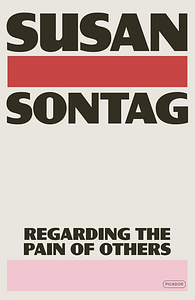You need to sign in or sign up before continuing.
Take a photo of a barcode or cover
informative
reflective
medium-paced
This was an interesting one because of how unique of a topic it is. It's not really something that I have put much thought into before. But yeah there is a lot to be said and a lot to talk about in terms of how people, especially those in the Western world, perceive war. A lot of times, especially now, people talk about war in a very impersonal and removed way. Because if it isn't directly affecting the, then they don't actually care. But yeah, especially in this age of the internet and social media, it is very easy to find videos and pictures and stories from wars happening in other places. But it can be hard to actually do something to help, when it feels like it is all happening so far away.
My one criticism of this book was that it felt too long. I think the point could have been entirely made in a third of the length. It ended up just repeating the few same talking points over and over again.
Read from the BYU library.
My one criticism of this book was that it felt too long. I think the point could have been entirely made in a third of the length. It ended up just repeating the few same talking points over and over again.
Read from the BYU library.
Graphic: Death, War
challenging
reflective
informative
reflective
tense
medium-paced
challenging
informative
reflective
slow-paced
challenging
dark
emotional
informative
inspiring
medium-paced
Sontag packs so much into just a hundred pages. This book is deceptively short given its emotional impact. Though written 20+ years ago it is still relevant given the increasing presence of violent images in the media. Sontag does have some weird comments throughout, though (like that historians don’t put any worth in politics?? what, Sontag?).
dark
informative
reflective
medium-paced
challenging
reflective
medium-paced
“The rest of us are voyeurs.”
Wow, Susan. Pop off.
It’s so interesting reading this now because, if anything, we are further desensitized to violent images than when the book was written. We have old problems in a new medium.
The ubiquity of the image through, say, instagram advocacy breeds a slightly different dynamic than the one Sontag interrogates here.
We are now all self-aware enough to recognize the rhetorical function of the image, and yet we behave as if we aren’t. All objectivity has been lost in favor of competing subjectivities. The democratization of photography through phone usage seems like it should have promoted the opposite effect, but reducing the likelihood of staging seems to have done little for “authenticity,” so now images of war exist almost purely as simulacra. The question is never one of artifice versus authenticity—it is a moot point. Rather than being concerned with whether something is propaganda, we focus instead on whether it’s effective propaganda.
At one point, Sontag asks, “Does shock have term limits?”
The answer is a resounding yes, but this truth intersects poorly with current morally coded discourse about “bearing witness” to travesty and condemning those who “look away.” In my mind, the need to look suggests a lack of empathy.
“Your pain is unreal until I see it.”
More importantly, it indicates, I think, a perverted need for ownership—distance with the pretense of proximity, a point Sontag alludes to.
“I will see your pain as I see fit.”
Furthermore, I think the problem is less about appetite—though I do think all consumption of such media has a voyeuristic impulse—and more about accountability. It’s like an inversion of the idiom “out of sight, out of mind.” By perpetually keeping the image in front of us at all times, it can be consumed, and if it can be consumed, it can be understood, and if it can be understood, it can be compartmentalized.
If the world is mediated on our own terms, we are only as culpable as we choose to be.
Wow, Susan. Pop off.
It’s so interesting reading this now because, if anything, we are further desensitized to violent images than when the book was written. We have old problems in a new medium.
The ubiquity of the image through, say, instagram advocacy breeds a slightly different dynamic than the one Sontag interrogates here.
We are now all self-aware enough to recognize the rhetorical function of the image, and yet we behave as if we aren’t. All objectivity has been lost in favor of competing subjectivities. The democratization of photography through phone usage seems like it should have promoted the opposite effect, but reducing the likelihood of staging seems to have done little for “authenticity,” so now images of war exist almost purely as simulacra. The question is never one of artifice versus authenticity—it is a moot point. Rather than being concerned with whether something is propaganda, we focus instead on whether it’s effective propaganda.
At one point, Sontag asks, “Does shock have term limits?”
The answer is a resounding yes, but this truth intersects poorly with current morally coded discourse about “bearing witness” to travesty and condemning those who “look away.” In my mind, the need to look suggests a lack of empathy.
“Your pain is unreal until I see it.”
More importantly, it indicates, I think, a perverted need for ownership—distance with the pretense of proximity, a point Sontag alludes to.
“I will see your pain as I see fit.”
Furthermore, I think the problem is less about appetite—though I do think all consumption of such media has a voyeuristic impulse—and more about accountability. It’s like an inversion of the idiom “out of sight, out of mind.” By perpetually keeping the image in front of us at all times, it can be consumed, and if it can be consumed, it can be understood, and if it can be understood, it can be compartmentalized.
If the world is mediated on our own terms, we are only as culpable as we choose to be.
challenging
reflective





